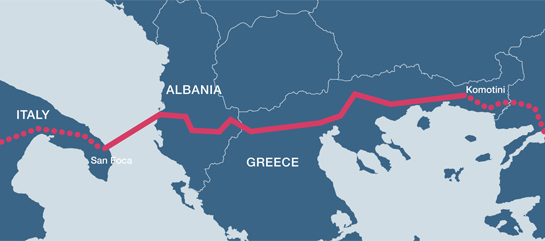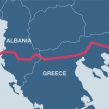
Trans-Adriatic Pipeline Project Considers Reconfiguration in TANAP’s Wake
Publication: Eurasia Daily Monitor Volume: 9 Issue: 148
By:

If the Trans-Adriatic Pipeline (TAP) project did not exist, it may have had to be invented (in this or some other form) by the Shah Deniz gas producers’ consortium in Azerbaijan, so as to foster commercial competition between TAP and the Nabucco-West pipeline project. The two projects compete over priority access to Shah Deniz gas, for transportation either to Italy by TAP or to Central Europe by Nabucco-West. The Shah Deniz producers’ consortium is launching separate, parallel negotiations with TAP and Nabucco-West over transportation tariffs, other commercial conditions, and acquisition of equity stakes by some Shah Deniz consortium members in either of the two rival projects. The producers’ consortium will evaluate the TAP and Nabucco-West offers comparatively and select one of them as the priority route for Shah Deniz gas to Europe.
The European Commission (more or less tacitly) and Azerbaijan (publicly) clearly favor Nabucco-West. However, the competitive threat to Nabucco-West by TAP might not be easily controlled and managed in the ways described. Within the Shah Deniz consortium, Norwegian Statoil has a vested interest in selecting TAP, of which Statoil is a major stakeholder and driving force. British Petroleum’s (BP’s) signals thus far seem ambivalent, hinting at a possible tilt toward the non-strategic TAP over the strategic Nabucco-West (see “Azerbaijan-Europe Gas Transportation Consortiums Face Major Restructuring,” EDM, August 3).
“Trans-Adriatic” is an obsolete and, by now, rather confusing title for this project. In fact, its “trans-Adriatic” section measures 105 kilometers, out of TAP’s pipeline route of more than 800 kilometers. This is nothing less than a trans-Balkan (correspondingly costly) project, with a trans-Adriatic offshore section grafted onto it. The line’s capacity is planned at 10 billion cubic meters (bcm) annually, precisely coinciding with the Shah Deniz Phase Two volume available for Europe (and corresponding with BP’s inclination toward a non-strategic pipeline for limited volumes of Azerbaijani gas). The pipeline route would start near the Turkish-Greek border at Komotini, running across northern Greece and Albania to Fier on the Adriatic coast, and crossing the seabed to the outermost point of the boot-shaped Italian peninsula’s heel. There, TAP would connect with Italy’s transmission grid operated by SNAM ReteGas.
According to TAP’s website, the last feasibility study for this project dates back to 2005-2006 and was conducted by the Swiss EGL (Elektrizitaetsgesellschaft Laufenburg), a major stakeholder in TAP. Since then, however, general economic conditions and TAP’s own parameters have changed. Updated cost estimates for the project do not seem to be publicly available (https://www.trans-adriatic-pipeline.com, accessed August 2).
The TAP consortium includes Norway’s Statoil and Swiss EGL (see above) with stakes of 42.5 percent each, and German E.On Ruhrgas with 15 percent of the shares. According to Doris Leuthard, Swiss Minister of Environment, Transport, Energy and Communications, “The gas market in Switzerland is still very closed, with effectively just one trading company.” Indeed, Switzerland buys gas from E.On Ruhrgas, which buys gas from Russia. Minister Leuthard made these remarks in Moscow during talks with Russian Energy Minister Aleksandr Novak on possible future “liberalization” of Switzerland’s gas market (Interfax Oil and Gas weekly report, July 16).
EGL is an energy-trading and service-providing company, with stakes in Swiss hydro- and nuclear-energy plants, and three gas-fired power plants in Italy with a combined capacity of 1,800 MW. The TAP project would (inter alia) supply EGL’s Italian plants with gas. EGL is 100 percent-owned by the AXPO holding, which is in turn 100 percent-owned by five Swiss cantons with their respective electricity companies (https://www.egl.eu/eglch; https://www.axpo.ch). All this is directly relevant to understanding the TAP project’s commercial intentions and target markets, at least from EGL’s and perhaps Ruhrgas’ perspective. Statoil’s perspective is less clear, apart from serving as middleman on the Azerbaijan-Italy route.
According to the TAP project company’s latest presentations (confirming the earlier ones), TAP would deliver Azerbaijani gas primarily to the Italian gas market. As a new element, however, it proposes to deliver some of that gas to Germany, using Italian pipelines south-north, onward to the Swiss transit pipelines, Transitgas, connecting with the German grid. Transitgas, currently operating north-south, is to be adapted for bi-directional use in the future (Trend, July 24, 27).
While the Swiss market is indeed monopolized (by Gazprom-Ruhrgas arrangements akin to those in some parts of Germany), the Italian gas market is fully saturated, as well as well-diversified in terms of suppliers and delivery routes (Russian, North African, Middle Eastern, pipeline-delivered and liquefied). It is the Nabucco-West countries that need extra volumes and supply diversification.
TAP also proposes to deliver some gas volumes to Albania along its route; the consortium has signed in 2011 memoranda of understanding on possible small-volume future deliveries to Bosnia-Herzegovina and Croatia, with declarative offers to Montenegro and possibly Kosovo. TAP presents this as a chance to diversify supplies in the Balkans or Southeastern Europe. Moreover, these intentions entail the construction of a 500-kilometer pipeline along the Adriatic coast from Albania to northern Croatia, with no financing in sight (https://www.trans-adriatic-pipeline.com).
Those intentions need not be taken at face value, however. The above-mentioned markets are nonexistent thus far in Albania, Montenegro, and Kosovo (all of which, according to TAP’s presentation, use no natural gas, and are not connected to a grid); while Croatia is 61 percent self-sufficient for natural gas, according to the same presentation. All these markets’ demand is minuscule, compared with volume demand and diversification demand in the countries along the Nabucco route, Bulgaria-Romania-Hungary-Austria (connected with Germany, where RWE and Bayerngas are interested in non-Russian gas). While TAP offers the hypothetical possibility of a storage site in Albania, Nabucco-West offers access to the existing and growing Baumgarten continental hub for Azerbaijani gas.
TAP faces the difficult problem of how to access Azerbaijani gas. The project company seems clearly tempted to connect TAP with the Trans-Anatolia Pipeline (TANAP), but equally considers using Turkish Botas state-owned pipelines for accessing Azerbaijani gas, as BP preferred until recently (and apparently has not conclusively abandoned this option). To connect with Botas pipelines, TAP proposes using the existing Interconnector Turkey-Greece (ITG). These are TAP’s “and/or” options (Trend, July 24, 27).
Using Botas pipelines “initially” (“temporarily”) for Azerbaijani gas could severely hurt TANAP; while a connection through ITG at the Turkish-Greek border would compete against Nabucco-West’s connection with TANAP at the Turkey-Bulgaria border.
Related to this problem is TAP’s lingering rivalry with Greece over gas transit pipelines. Greece is supposed to host TAP on its territory, but does not participate in TAP. The Greek transmission pipeline company, DESFA, has its own project, known as Interconnector Greece-Italy and the Poseidon pipeline across the Ionian Sea to Italy, jointly with Italian Edison. Moreover, Greece has long objected to Albania being included in the TAP pipeline route. The Shah Deniz consortium selected TAP over the DESFA-Edison project in February of this year (2012); but TAP needs to somehow co-opt DESFA in order to secure Greek cooperation with TAP on Greek territory. DESFA’s cooperation would also be needed for TAP to connect with Botas through the ITG.
TAP is a corporate business project. It is a non-strategic project in terms of volumes or the markets it is targeting. It would divert Caspian gas supplies to countries that are already amply supplied and well connected to European transport systems for diversification – away from countries that need additional supplies, connections to transport systems and, above all, the diversification of supplies. TANAP and Nabucco-West propose to achieve these objectives.
According to the TAP project company, the pipeline’s capacity can be doubled, from 10 to 20 bcm annually, by adding compressor capacity, if larger Caspian gas volumes become available. Diverting that amount away from Central Europe toward Italy would turn TAP from a non-strategic into an anti-strategic project.




